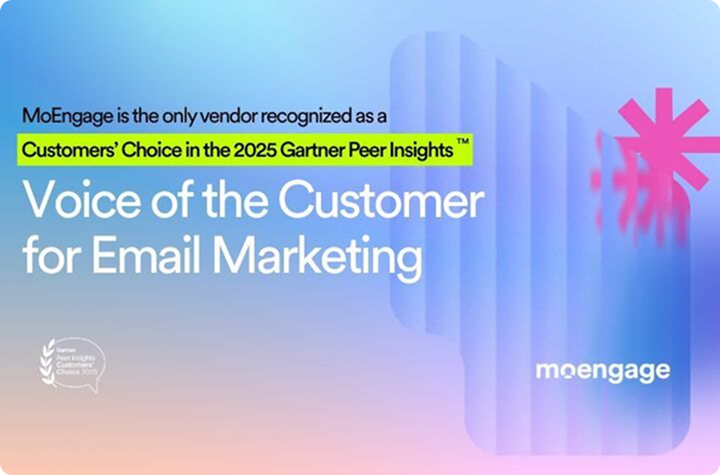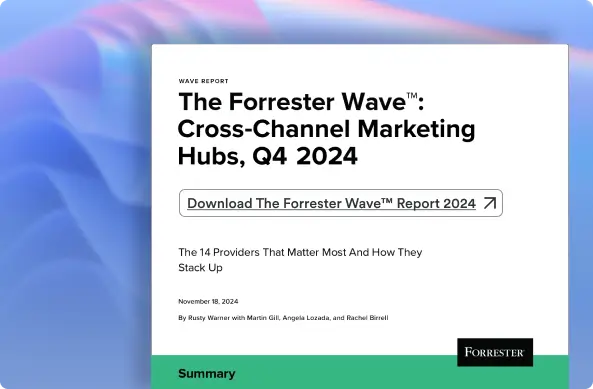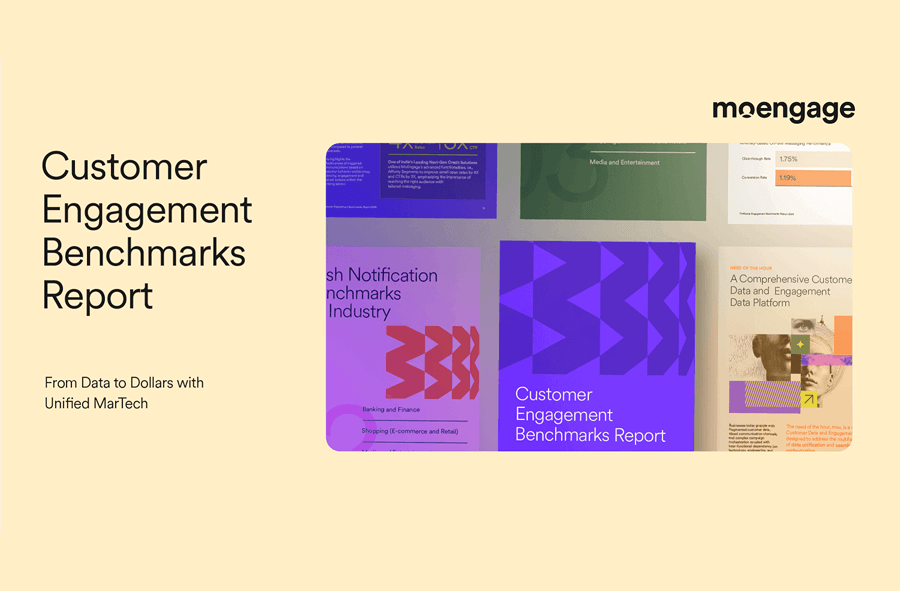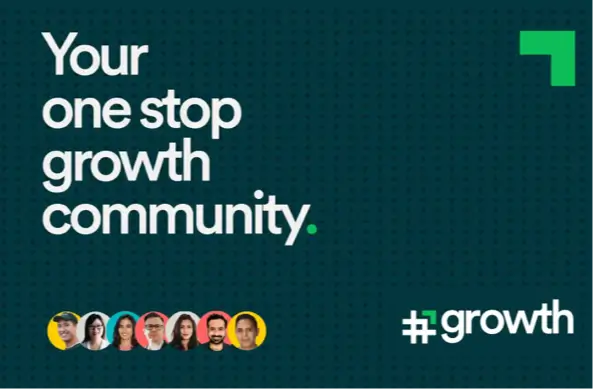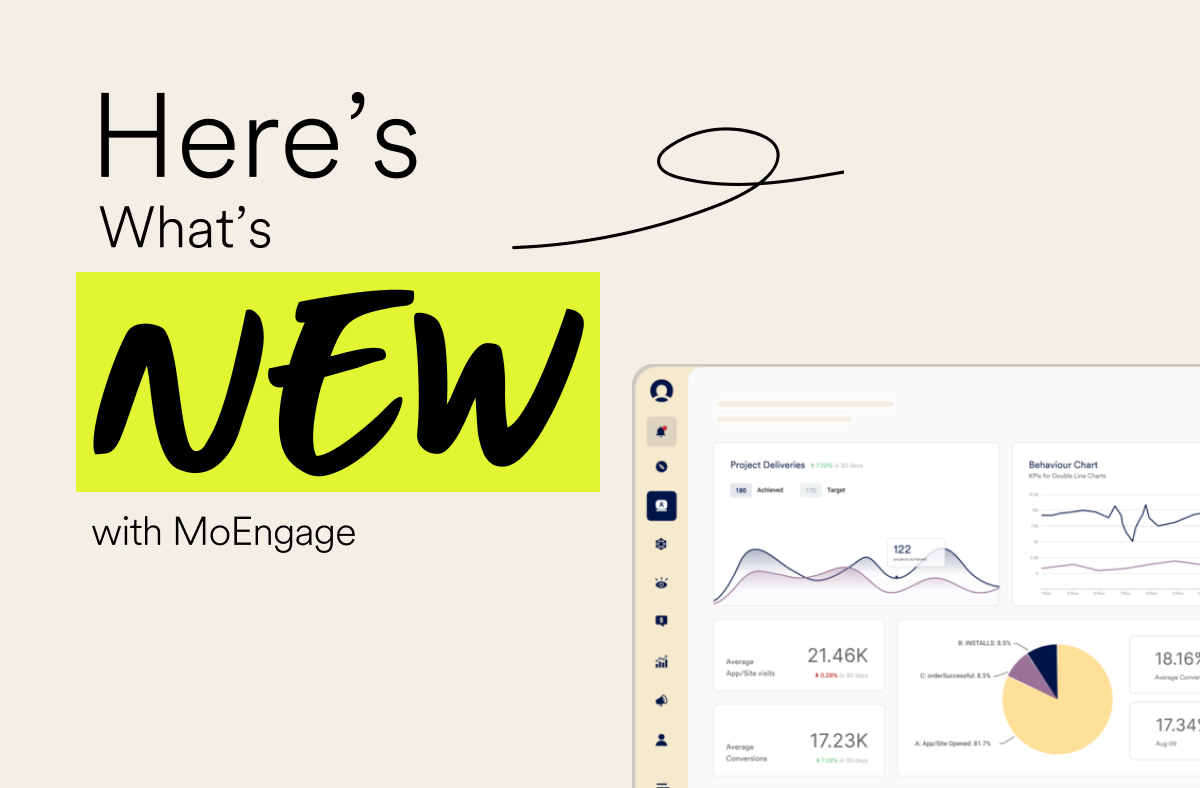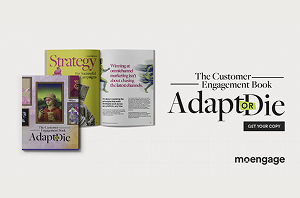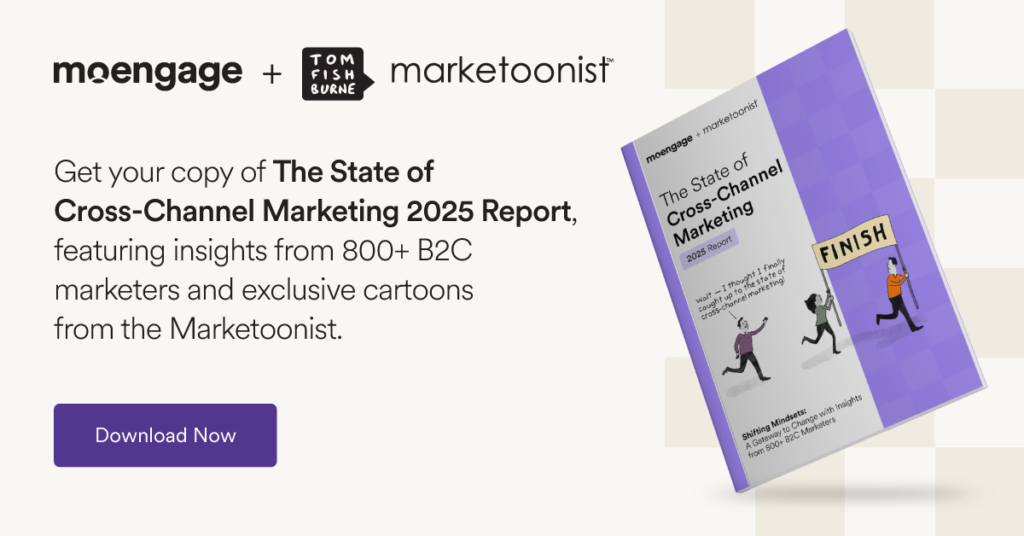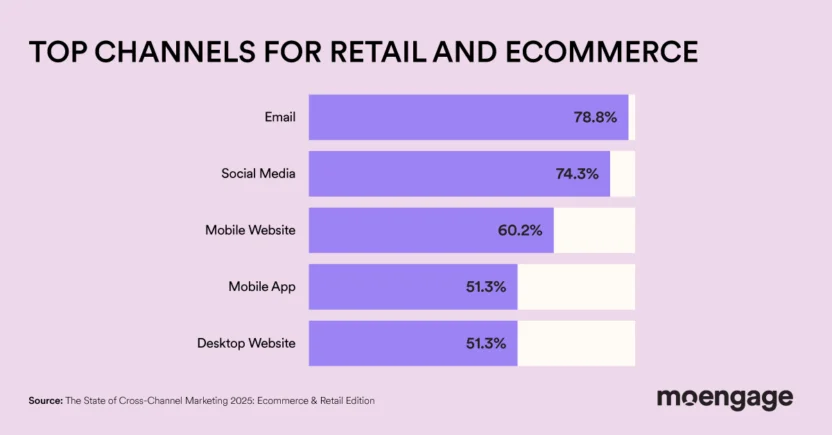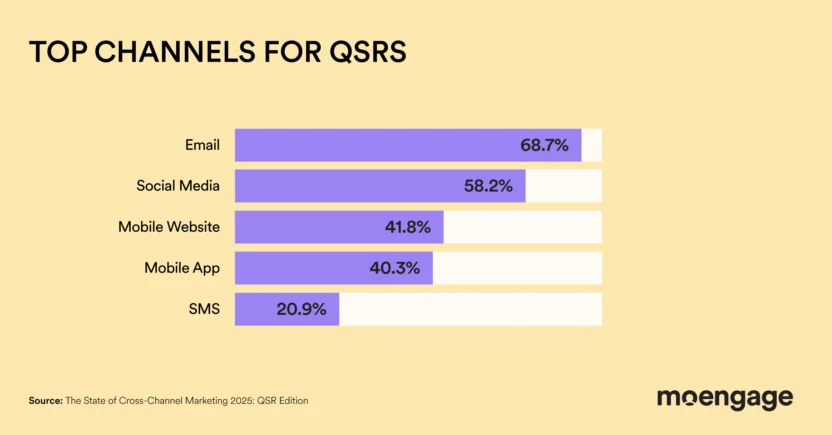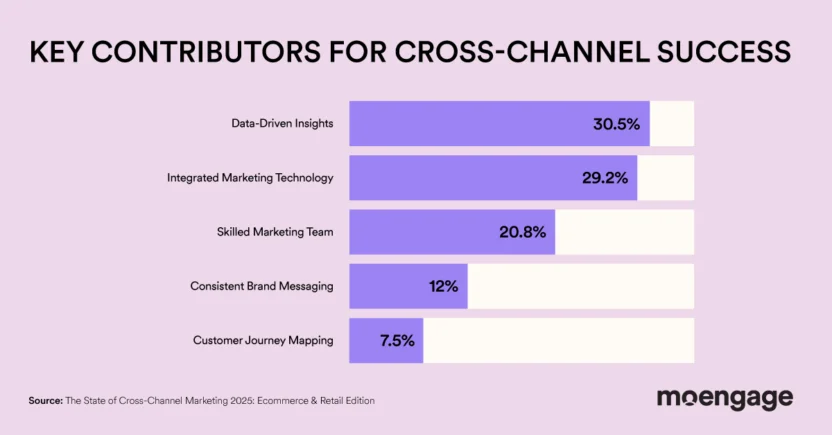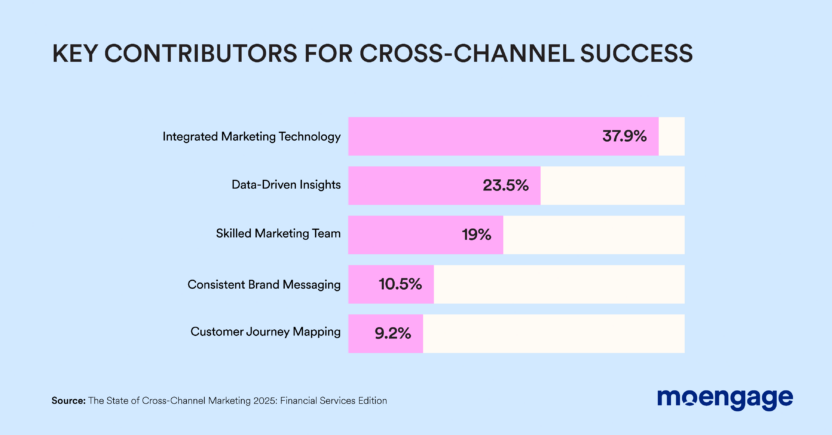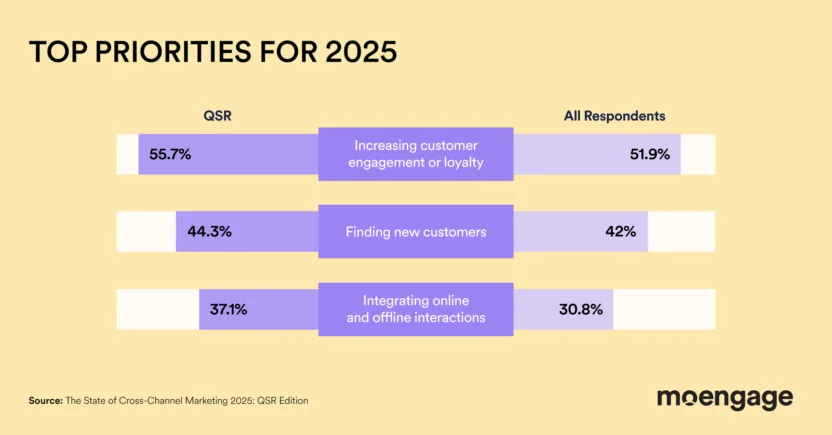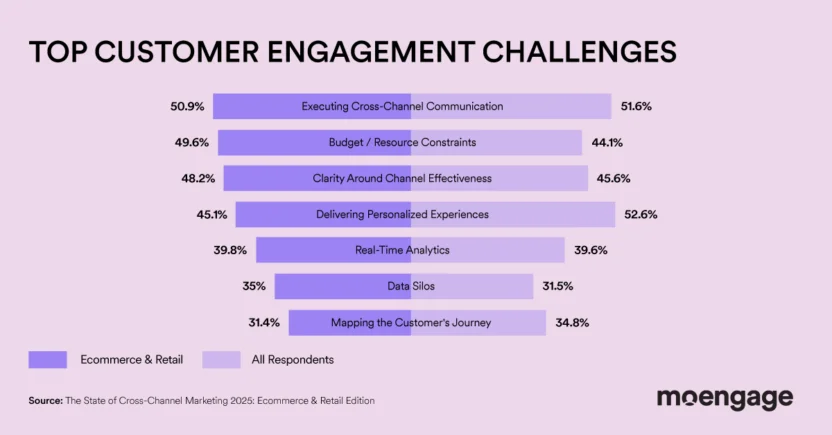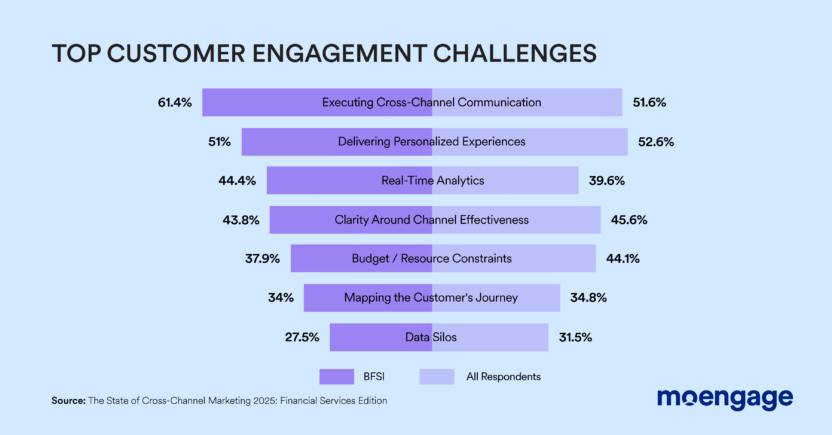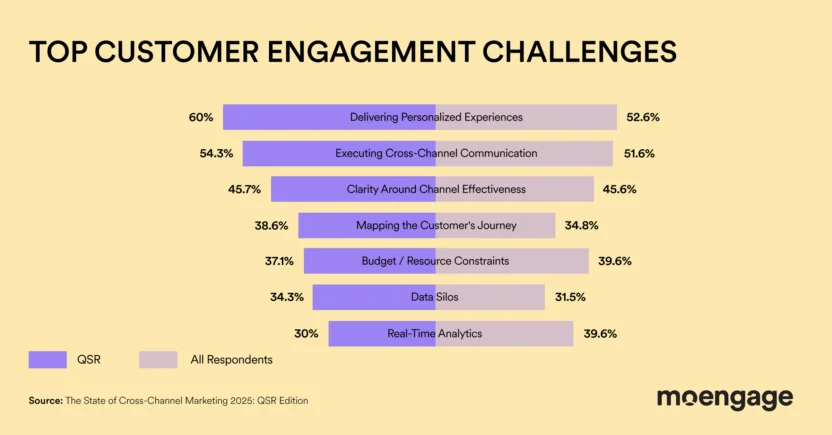60+ Incredible Omnichannel Marketing Statistics for 2025 [Original Research]
![60+ Incredible Omnichannel Marketing Statistics for 2025 [Original Research]](https://www.moengage.com/wp-content/uploads/Featured-Image-2.png)
Reading Time: 8 minutes
In today’s hyper-connected world, customers demand seamless experiences across every touchpoint – whether it’s a targeted push notification, a personalized email, or an in-store interaction. For brands, this means mastering omnichannel marketing is no longer a choice; it’s a necessity. But what does the future hold for cross-channel engagement? How are industries like Retail and Ecommerce, BFSI (Banking, Financial Services, and Insurance), and QSR (Quick Service Restaurants) adapting to shifts in consumer behavior and expectations? The answers lie in fresh data and insights from our The State of Cross-Channel Marketing 2025 report.
In this blog, we’ve curated the most compelling omnichannel marketing statistics and industry-specific insights to help you unlock what’s next. From channel usage and top priorities to emerging challenges and best practices, these omnichannel statistics will give you the competitive edge you need in 2025.
Let’s dive into the numbers!
Omnichannel Marketing Statistics for Channel Usage
The success of an omnichannel marketing campaign relies heavily on selecting the right mix of communication channels. The cross-channel marketing statistics below showcase which channels B2C marketers find most effective and those seeing lower adoption.
General Omnichannel Statistics
- The top five channels B2C marketers across industries are using in 2025 are: Email (82.4%), Social Media (66.7%), Mobile Website (58%), Desktop Website (52.7%), and Mobile App (51.6%).
- Email remains the #1 channel used (82.4%) and the one perceived as most effective (73.5%).
- WhatsApp’s usage as a marketing channel has more than doubled this year (from 13.5% to 34.8%).
- Only 26.9% of marketers are leveraging offline channels for marketing.
- The least popular digital marketing channel among marketers is Desktop push (16.5%).
- On average, B2C marketers use at least five channels to execute their customer engagement campaigns effectively.
Omnichannel Retail and Ecommerce Statistics
- The top five channels B2C marketers from the Retail and Ecommerce industry are using in 2025 are: Email (78.8%), Social Media (74.3%), Mobile Website (60.2%), Mobile App (51.3%), and Desktop Website (51.3%).
- Email remains the #1 channel used (78.8%) for the Retail and Ecommerce industry and the one perceived as most effective (71.6%).
- WhatsApp’s usage as a marketing channel has more than doubled this year for the Retail and Ecommerce industry (from 17.1% to 36.3%).
- Only 28.3% of Retail and Ecommerce marketers are leveraging offline channels for marketing.
- The least popular digital marketing channel among Retail and Ecommerce marketers is Desktop push (16.4%).
Omnichannel Banking and Financial Services Statistics
- The top five channels BFSI marketers are using in 2025 are: Email (81.1%), Mobile App (68.6%), Social Media (68.0%), Mobile Website (61.4%), and Desktop Website (48.4%).
- Email remains the #1 channel used (81.1%) for the BFSI industry and the one perceived as most effective (75.2%).
- WhatsApp’s usage as a marketing channel has increased significantly this year for the BFSI industry (from 11.56% to 43.1%).
- Only 20.3% of BFSI marketers are leveraging offline channels for marketing.
- The least popular digital marketing channel among BFSI marketers is Desktop push (22.9%).
Omnichannel Quick Service Restaurants Statistics
- The top five channels B2C marketers from the QSR industry are using in 2025 are: Email (68.7%), Social Media (58.2%), Mobile Website (41.8%), Mobile App (40.3%), and SMS (20.9%)
- Email remains the #1 channel used (68.7%) for the QSR industry and the one perceived as most effective (75.2%).
- The least popular digital marketing channel among QSR marketers is Desktop push (6%).
Omnichannel Marketing Statistics for Top Priorities
As you refine your omnichannel strategies for 2025, you must be mindful of certain goals and investments that are taking center stage. The omnichannel marketing statistics below highlight the top priorities for marketers across different industries, including key business objectives, plans for Martech investment, and critical factors for evaluating customer engagement platforms (CEPs).
General Omnichannel Statistics
- The most popular business objective for B2C Marketers in 2025 is increasing customer engagement or loyalty (51.9%).
- 30.8% of B2C marketers say integrating online and offline interactions is one of the top objectives for their company in the next 12 months.
- 31% of marketers credit “integrated marketing technology” as the #1 component for building effective cross-channel marketing strategies.
- 79.3% of B2C marketers plan to invest more in marketing technology to improve customer experiences in the next 12 months.
- The top two requirements for B2C marketers purchasing a customer engagement platform are positive reviews on software comparison sites like G2, Gartner, and Forrester (54.2%) and capabilities to facilitate personalization and cross-channel engagement (54%).
Omnichannel Retail and Ecommerce Statistics
- The most popular business objective for Retail and Ecommerce marketers in 2025 is finding new customers (48.7%).
- 31.0% of Retail and Ecommerce marketers say integrating online and offline interactions is one of the top objectives for their company in the next 12 months.
- 29.2% of Retail and Ecommerce marketers credit “integrated marketing technology” as the #1 component for building effective cross-channel marketing strategies.
- 80.1% of Retail and Ecommerce marketers plan to invest more in marketing technology to improve customer experiences in the next 12 months.
Omnichannel Banking and Financial Services Statistics
- The most popular business objective for BFSI marketers in 2025 is increasing customer engagement or loyalty (44.4%).
- 30.1% of BFSI marketers say integrating online and offline interactions is one of the top objectives for their company in the next 12 months.
- 37.9% of BFSI marketers credit “integrated marketing technology” as the #1 component for building effective cross-channel marketing strategies.
- 81.1% of BFSI marketers plan to invest more in marketing technology to improve customer experiences in the next 12 months.
Omnichannel Quick Service Restaurants Statistics
- The most popular business objective for QSR marketers in 2025 is increasing customer engagement or loyalty (55.7%).
- 37.1% of QSR marketers say integrating online and offline interactions is one of the top objectives for their company in the next 12 months.
- 30% of QSR marketers credit “integrated marketing technology” as the #1 component for building effective cross-channel marketing strategies.
- 80% of QSR marketers plan to invest more in marketing technology to improve customer experiences in the next 12 months.
Omnichannel Marketing Statistics for Top Challenges
Executing effective cross-channel strategies comes with its own set of hurdles. The omnichannel marketing statistics below shed light on the biggest challenges B2C marketers face, from overcoming data silos to personalizing engagement at scale and measuring the impact of their efforts across different channels.
General Omnichannel Statistics
- The #1 challenge for B2C marketers in driving customer engagement is delivering personalized experiences (52.6%) vs. budget constraints which was the #1 response in 2024.
- The second biggest challenge for B2C marketers in driving customer engagement is seamlessly executing omnichannel communication (51.6%).
- 45.6% of B2C marketers say their biggest challenge in driving customer engagement is not having clarity around channel effectiveness.
- The #1 barrier for marketers executing hyper-personalized campaigns is “slow execution” due to manual processes or rigid technology / clunky tools (31%), which impede them from reacting quickly.
- 23.6% of B2C marketers say reconciling digital and offline marketing channel data is the #1 difficulty they encounter when executing omnichannel communication.
- 31.6% of B2C marketers say their analytics and measuring capabilities are too limited, and 27.3% cite siloed data as a culprit.
Omnichannel Retail and Ecommerce Statistics
- The #1 challenge for Retail and Ecommerce marketers in driving customer engagement is executing omnichannel communication seamlessly (50.9%) vs. budget constraints, which was the #1 response in 2024.
- 48.2% of Retail and Ecommerce marketers say their biggest challenge in driving customer engagement is not having clarity around channel effectiveness.
- 23.9% of Retail and Ecommerce marketers say “reconciling digital and offline marketing channel data” is the #1 difficulty they encounter during omnichannel retail marketing.
Omnichannel Banking and Financial Services Statistics
- The #1 challenge for BFSI marketers in driving customer engagement is executing omnichannel communication seamlessly (61.4%).
- 43.8% of BFSI marketers say their biggest challenge in driving customer engagement is not having clarity around channel effectiveness.
- 18.6% of BFSI marketers say “reconciling digital and offline marketing channel data” is the #1 difficulty they encounter when creating omnichannel customer experiences.
Omnichannel Quick Service Restaurants Statistics
- The 2nd biggest challenge for QSR marketers in driving customer engagement is seamlessly executing omnichannel communication (54.3%).
- 45.7% of QSR marketers say their biggest challenge in driving customer engagement is not having clarity around channel effectiveness.
- 25.4% of QSR marketers say “reconciling digital and offline marketing channel data” is the #1 difficulty they encounter when creating omnichannel customer experiences.
Omnichannel Marketing Statistics for Best Practices
As omnichannel marketing evolves, so do the strategies and tools fueling its success. The omnichannel statistics below highlight how B2C marketers are leveraging personalization and AI, the growing adoption of these strategies year-over-year, and the top methodologies and use cases driving impactful customer engagement.
General Omnichannel Statistics
- In 2024, 10.1% of B2C marketers said they weren’t personalizing their marketing communications, but this year, only 2.9% said so.
- The #1 method of personalization is tailoring messages based on customer actions/interactions (55.2%).
- The 2nd most popular method of personalization is tailoring messages based on age, gender, location, etc. (48.4%).
- In 2024, 20.8% of B2C marketers claimed they were using manual processes and spreadsheets to manage their omnichannel marketing programs, but this year, only 6.9% are doing so.
- In 2024, 22.8% of B2C marketers said they were not using AI as part of their omnichannel marketing strategy, but that number dropped to 4.6% this year.
- The top two use cases of AI for omnichannel marketing amongst B2C marketers are content creation (57%) and email optimization (53.4%).
Omnichannel Retail and Ecommerce Statistics
- In 2024, 8.1% of Retail and Ecommerce marketers said they weren’t personalizing their marketing communications, but this year, only 5.3% said so.
- The #1 method of personalization amongst Retail and Ecommerce marketers is tailoring messages based on customer actions/interactions (57.5%).
- In 2024, 20.7% of Retail and Ecommerce marketers said they were not using AI as part of their omnichannel marketing strategy, but that number dropped to 4.4% this year.
- The top two use cases of AI for omnichannel marketing within the Retail and Ecommerce industry are email optimization (58.9%) and content creation (54%).
Omnichannel Banking and Financial Services Statistics
- In 2024, 8.8% of BFSI marketers said they weren’t personalizing their marketing communications, but this year, only 2.6% said so.
- The #1 method of personalization amongst BFSI marketers is tailoring messages based on customer actions/interactions (60.8%).
- In 2024, 20.4% of BFSI marketers said they were not using AI as part of their omnichannel marketing strategy, but that number dropped to 5.9% this year.
- The top two use cases of AI for omnichannel marketing within the BFSI industry are content creation (58.8%) and email optimization (55.6%).
Omnichannel Quick Service Restaurants Statistics
- In 2024, 4.3% of QSR marketers said they weren’t personalizing their marketing communications, but this year no one said so.
- The #1 method of personalization amongst QSR marketers is using information on age, gender, location, etc. (48.6%).
- In 2024, 14.9% of QSR marketers said they were not using AI as part of their omnichannel marketing strategy, but that number dropped to 2.9% this year.
- The top two use cases of AI for omnichannel marketing within the QSR industry are content creation (50%) and developing customer behavior-based messaging (48.6%).
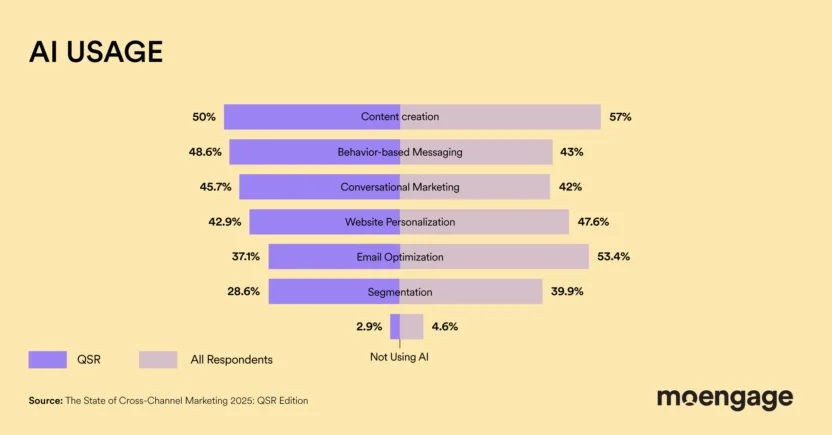
Key Takeaways from 2025 Omnichannel Marketing Statistics
The 2025 omnichannel marketing statistics highlight the growing emphasis on personalized engagement, multiple use cases of AI, and how B2C marketers are ensuring seamless cross-channel communication. While opportunities abound, challenges like outdated technology and inactionable data remain top concerns for marketers. For a deeper understanding of these trends and insights, explore the full State of Cross-Channel Marketing 2025 report and create omnichannel campaigns that help you achieve your ROI goals.



